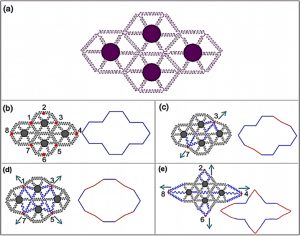From the Journal: Applied Physics Letters
WASHINGTON, D.C., September 10, 2019 — Medical implants of the future may feature reconfigurable electronic platforms that can morph in shape and size dynamically as bodies change or transform to relocate from one area to monitor another within our bodies.
In Applied Physics Letters, from AIP Publishing, a group of researchers from King Abdullah University of Science and Technology and University of California, Berkeley reports a silicon honeycomb-serpentine reconfigurable electronic platform that can dynamically morph into three different shapes: quatrefoils (four lobes), stars and irregular ones.

“Quatrefoils can be used for rectangular object-based operation, while stars are for more intricate architectures, and irregular-shaped ones are specifically for implanted bioelectronics,” said Muhammad Hussain, co-author and a visiting professor at the University of California, Berkeley.
With their work, the researchers are introducing a new branch of flexible, stretchable electronics — opening the door to new engineering challenges and providing opportunities for innovation in biomedical technologies that can be used for drug delivery, health monitoring, diagnosis, therapeutic healing, implants and soft robotics.
Inspiration for the group’s honeycomb-shaped platform comes from nature. “Think of how flowers bloom. Based on the same principle, we gathered many videos of flowers blossoming, analyzed their geometric pattern and used them for our first set of designs,” Hussain said. “In particular, we analyzed their stress distribution in an iterative manner, taking design architecture, materials and their properties into consideration. It’s a tedious process to reach the optimal balance, but this is where engineering helps.”
Reconfigurable electronic platforms are designed to undergo physical deformation, such as stretching, bending, folding or twisting to morph into another shape. “Imagine that a lab-on-chip platform is implanted within your body to monitor the growth of a tumor in the shoulder area,” said Hussain. “While it is implanted, if we observe some abnormality in lung function, a platform that is equipped enough can change its shape and size, and relocate or expand to go monitor lung function.”
Another idea the researchers are actively pursuing is a wearable heart sleeve to monitor heart activity with the ability to mechanically pump the heart by repeated expansion and contraction when needed.
“We still have a long way to go to integrate soft robotics with embedded high-performance flexible complementary metal-oxide semiconductor (CMOS) electronics on a variety of reconfigurable electronic platforms, which will be of immense importance,” Hussain said. “It offers wonderful engineering challenges, requires true multidisciplinary efforts and has the ability to bind a variety of disciplines into applications that are simply not possible with the existing electronics infrastructure.”
###
For more information:
Larry Frum
media@aip.org
301-209-3090
Article Title
Honeycomb-serpentine silicon platform for reconfigurable electronics
Authors
A. Damdam, N. Qaisar and M.M. Hussain
Author Affiliations
King Abdullah University of Science and Technology and University of California, Berkeley
